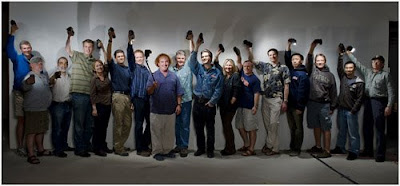
Pictured above are the students in last week's five-day lighting class in Paso Robles, CA. Teaching one of these extended classes was a first for me. And while I was expecting a fun, intense week, what was more interesting was watching the students to see how they learned.
That was an eye-opener, to say the least. We had a wide range of ages, personalities and learning styles. And I am more convinced than ever that anyone -- anyone -- can learn to light in a relatively sophisticated way in a pretty short amount of time.
Some thoughts, punctuated by their photos, after the jump.
__________
NOTE: Photos are credited at the bottom of the post. Click on any photo to see it bigger in a new window.
The Usual Suspects
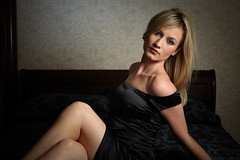 One of my biggest apprehensions before the week was having no idea where the students would be, ability-wise, when they arrived. Would some of them be long-time pros? Would some be rank beginners? Worse yet -- maybe a mix of both?
One of my biggest apprehensions before the week was having no idea where the students would be, ability-wise, when they arrived. Would some of them be long-time pros? Would some be rank beginners? Worse yet -- maybe a mix of both?So we spent some time Monday morning looking at photos and getting to know each other. And as it turned out, the class was a decent cross section of the readership of this site.
They were mostly amateurs, and some transitional pros. We had businesspeople, a dentist, a pioneering punk rocker-turned rock doc filmmaker -- even a cog in the military-industrial complex. We had all ages, from a 22-year old bachelor to several
In the end their age, profession, skill level and/or personality type really didn't matter when it came to seeing how they progressed. Which is really cool when you think about it, and also nukes about 90 percent of the excuses people have for not jumping into this stuff head first.
Left Brain, Right Brain
 Many people look at lighting as a technical thing. In reality it is about as technical as playing with the bass and treble knobs on your stereo. And about as difficult, truth be told. I would rather be math-challenged and very creative and be learning this stuff than to be an engineer with the same goal.
Many people look at lighting as a technical thing. In reality it is about as technical as playing with the bass and treble knobs on your stereo. And about as difficult, truth be told. I would rather be math-challenged and very creative and be learning this stuff than to be an engineer with the same goal.Why? Because absolutely anyone can learn to do it. And when it is said and done, you'd rather be a creative person who knows how to light than a tech-head with yet one more new skill in your back pocket.
The biggest hurdle with learning to light is just deciding to do it. It's math anxiety, or being afraid to walk across the room and invite a partner onto the dance floor in sixth grade, or just about anything else that has seemed intimidating -- until you learned how to do it.
It's Not About the Gear, Either
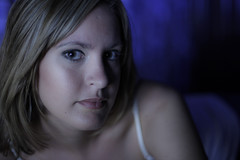 Syl Arena is the proprietor of Paso Robles Workshops, where we were all learning together. (Syl's the guy under he mop of red hair at center left.) He and I originally planned on forming the class into teams based on their brand of gear and various synching methods. In the end we ended up rotating them into a completely new group every day, making for a more diverse experience for the whole class.
Syl Arena is the proprietor of Paso Robles Workshops, where we were all learning together. (Syl's the guy under he mop of red hair at center left.) He and I originally planned on forming the class into teams based on their brand of gear and various synching methods. In the end we ended up rotating them into a completely new group every day, making for a more diverse experience for the whole class.We quickly realized it was not the gear that was important. Throughout the week, I could not discern any correlation between how fast someone picked up new skills and the weight of their gear bag. To be sure, you do need some stuff. But you do not need to go into hock on a bunch of high-end bodies, lenses and strobes to get great results. So, for those of you who have more time than money, take heart.
In fact, to be honest I think being a gear hog can be a handicap when learning. Practice frequently and learn to use what gear you have. Then slowly add gear only when you have a specific need. You'll make better photos that way, plus you'll prolong the fun process of gearing up.
It's All About Balance
 After this week I feel even more strongly that the key to understanding lighting is to become very comfortable with the concept of balance. We have talked about it in L101 and L102, and in just about every OA post. But everything comes down to how well you understand this concept. All of the other stuff is icing on the cake.
After this week I feel even more strongly that the key to understanding lighting is to become very comfortable with the concept of balance. We have talked about it in L101 and L102, and in just about every OA post. But everything comes down to how well you understand this concept. All of the other stuff is icing on the cake.In its simplest form, begin by assessing your ambient. Make a normally exposed photo. Tamp down the exposure a little, until you get a photo that would make a nice "floor" exposure for your final, lit image. Then lay in your light, be it soft and flattering, hard and edgy, or anything in between. We have a little visual run-through of that process coming shortly. And that will reiterate just how easy it is.
Once you get that ambient/flash two-step down pat, you can begin your all-flash photos that way, too. Now you can lay in your fill, ensuring that whatever your key fails to illuminate will fall to exactly what you want. And now you have control over both the quantity and quality of your fill, which is when the photos really start to get interesting.
All of the various styles of key lighting, the light mods, synch methods, gelling, etc., rely on the foundation of balance. Unlock balance, and everything falls into place.
Build Muscle Memory
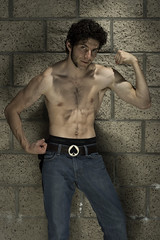 Once you get the concept, play. A lot. That is a big part of the strength of a five-day workshop -- total immersion learning. I demo'd on Monday, and they shot every other day.
Once you get the concept, play. A lot. That is a big part of the strength of a five-day workshop -- total immersion learning. I demo'd on Monday, and they shot every other day. But you can do it at home, too. Make headshots of family and friends. Photograph your own house as a project. Try new fill methods and accent lighting styles.
Reps matter -- every time you previsualize a photo in your mind then pull it off with your camera and flashes, you get better. Heck, by the time they walked in with their shoot on Thursday morning, many were almost looking a little cocky.
With practice, you also get more comfortable stretching your comfort zone. Do it again and again until you are so familiar with the balancing light that it is almost subconscious.
The majority of the fifteen people that showed up one week ago on an chilly Monday morning were amateurs who could best be described as "tentative" in their approach to lighting. We had some nice stuff in the opening images, of course. But most everyone there had more desire to learn than experience at that point.
By the end of the week the problems were far more granular, which is to say that the big stuff was being solved easily. And there was a comfort level that belied where they were just a five days ago. People were taking chances, engaging their subjects and lighting almost intuitively. Almost.
Don't Forget to Make a Picture
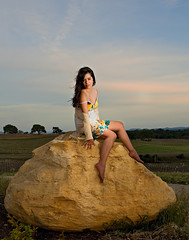 Lots of rookie lighting photogs crash here. They spend so much energy working out the light that they neglect the most important part of the process. Save your subjects' attention spans for when you are done with the lighting tweaks away and ready to start making photos.
Lots of rookie lighting photogs crash here. They spend so much energy working out the light that they neglect the most important part of the process. Save your subjects' attention spans for when you are done with the lighting tweaks away and ready to start making photos. Engage your subjects. Work through a steady stream of conversation. Don't stick them up there like a mannequin and bore them silly by shooting a frame and disappearing into chimping mode. Seriously, I see this a lot and it is a really bad thing.
That brings us back to muscle memory concept. It is just like doing math. The better your algebra is, the more comfy you will be with the trig. When lighting, if your technical stuff is effortless, you are free to engage the subject with all of your attention. That pays off with great photos -- that happen to be beautifully lit.
Collaborate
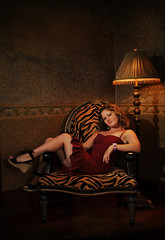 The dynamic of team learning is hard to beat. Go to a meetup. Find another local shooter and practice some together. They understand you way better than your poor spouse does. Another lighting photographer will be a VAL (voice-activated light stand) or VAB (same, but a boom) for you until their arms fall off, simply because they want to see what the light can do from way up there, too.
The dynamic of team learning is hard to beat. Go to a meetup. Find another local shooter and practice some together. They understand you way better than your poor spouse does. Another lighting photographer will be a VAL (voice-activated light stand) or VAB (same, but a boom) for you until their arms fall off, simply because they want to see what the light can do from way up there, too.Collaborate with other photogs to gain confidence, then collaborate with subjects toward the goal of making interesting photos. Everyone wins, and you get better fast.
Seventeen Shooters, Eighteen Flashes
For our quickie group shot seen up top (it took us about ten minutes, soup to nuts) we decided to light entirely by flash. This was done by shooting at a 250th of a sec at a decent aperture -- way above the ambient. We had a PW'd Canon speedlight on a stand in a shoot-thru right next to the camera. Almost a ring light look, if you will.
We exposed for the umbrella fill and then closed down the aperture about two stops. At that point, all that was left was for everyone to light themselves with either an SU-4'd SB-800 or an LP120. (Tim, close to the middle, had a Canon speedlight with an off-board slave, I think.)
The contrast range was courtesy the ratio between the facelights and the umbrella fill; key light courtesy the subjects.
About the Photos on This Page
The images seen here were done by (mostly) amateur and transitional pro shooters, and for the most part without my involvement. We lectured hard on Monday afternoon and Tuesday morning, then shot each other on Tuesday afternoon. On Wednesday and Thursday we got access to models and two very different locations.
For Friday's assignment, we turned up the pressure several notches. (I wouldn't want to ruin the surprise unless we do it again, and if you tip anyone in the comments you won't be published.) But suffice to say I could have called in sick on Friday and these guys still would have knocked the cover off of the ball.
Credits, in order from top: Everyone in the group photo (it was a self-timer shot), Steven Nguyen, William Yu, Tim Bosma, Sam Graham, Sean Rolsen, Richard Clary and Victory Tischler-Blue.
__________
SPECIAL NOTE TO THE PRW STUDENTS: Whittling down the selects list was a bear, and very sorry to not have something from all 15 shooters. If you would like your credit to link someplace, shoot me an email from the address used in the Paso Robles group email list and let me know where to link it. I will do so ASAP-est.
Thanks much for for such an awesome week. It was a total pleasure to work with you guys.




0 comments:
Post a Comment